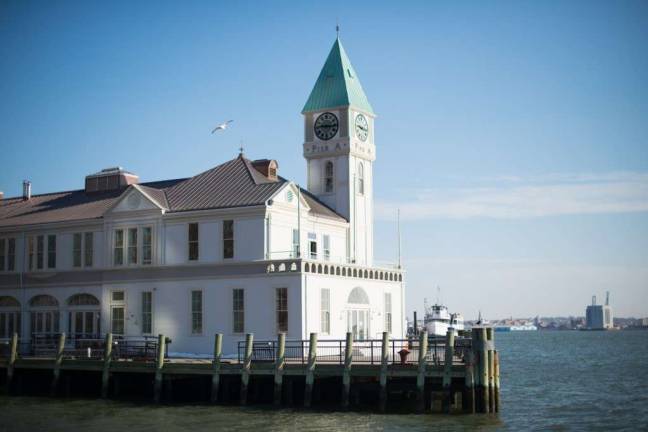Signs of life on Pier A

A long-ignored structure on the tip of Manhattan gets a restaurant spiced with history
Battery Park City For more than two decades, Pier A has sat empty, decrepit and neglected on the tip of Lower Manhattan just across from Ellis Island.
Built in 1884 as the headquarters of the New York harbor police, it was used in the 1960s by FDNY fire boats. Also known as Liberty Gate, the pier was the first stop for foreign VIPs entering the country by boat through New York.
Since 1992 though, the pier has fallen into disrepair and neglect, with several development falling through in the decades since then.
But in 2008, the Battery Park City Authority started a $30 million restoration that would turn the pier into a public space with an expansive promenade and improved waterfront access. In 2011 the BPCA awarded veteran Financial District restaurateur Peter Poulakakos a lease to run a restaurant on the pier, a plan that could come to fruition as early as June.
Poulakakos and his father, Harry, own and operate several restaurants in the Financial District, including Harry's Steakhouse and Ulysses Folk House, among others throughout Lower Manhattan. Their company, HPH, has a stable of 11 bars and restaurants in their portfolio.
What to expect
When crafting Pier A's future, the city and the BPCA were interested in maintaining a portion of the historic pier as a public space. "It was always part of the plan, absolutely," said Anthony Notaro, chair of Community Board 1's Battery Park City Committee.
At a BPC committee meeting last week, a handful of representatives from HPH outlined some of their plans for Pier A, which is now fully restored.
"We've designed it almost like a parked cruise ship," said Danny McDonald, a partner with HPH in their Ulysses restaurant who is also involved in the Pier A project. "The downstairs, which we call the long hall, at one point was really the center for VIP immigration and we're dedicating it to all those people who came through this area."
During warm months, a series of French doors on the first level of Pier A will be open, allowing for a cross-breeze coming off the harbor and the Hudson River. The first level, which will be free and open to the public, will feature an oyster bar and a visitor's center. The promenade around the pier will also be free and open to the public.
McDonald said the restaurant on the second level is "more like a programmed area," that will feature several historical flourishes. "There's a lot of little rooms there, and each room gives us an opportunity to pay special homage to the different aspects and histories of the pier."
For example, McDonald said, one room is dedicated to W.R. Grace, who as mayor of New York City in 1886 received the Statute of Liberty from the French. Pier A will also integrate 170 steam ship gauges from the 1880s that were found in the pier during its renovation. The second floor will also feature two distinct bars in addition to the restaurant.
"We're not skipping a beat on any of the homages that we're trying to pay to the [pier's] historic significance," said McDonald.
The third floor will be an events and performance space with its own dedicated bar that will be available to rent.
Not everyone happy with proposal
The plan is not without controversy. In 2011, Italian American activist Joseph Grano submitted a proposal to turn the pier into an Italian-American museum, but lost the bid to HPH. Several CB1 members also opposed any development plan that featured a restaurant, and said that Italian-Americans had no cultural reference point in an area that they helped form.
"The state spent $30 million dollars to make it ready for them to build this restaurant, it's ridiculous," said John Fratta, a CB1 member who chairs the board's Seaport Committee.
As for the historical touches included HPH's proposal, Fratta said he's glad they're mindful of the pier's significance in Lower Manhattan, but "let's see what they actually do."
Fratta doesn't blame the Poulakakos family for expanding their business, but said the BPCA should have given more weight to the area's Italian-American heritage when awarding the bid.
"We feel that there's no Italian-American presence in that area," said Fratta, who pointed to the nearby Holocaust museum, Irish Hunger Memorial and the American Indian museum. "The Italian-American community has nothing in that area to show that we exist, and that's where our ancestors first stepped into this country."
But Notaro said that HPH and the Poulakakos family have always been respectful of the areas in which they develop restaurants.
"Harry [Poulakakos] has a great track record in Lower Manhattan so we know that he's going to make it a success," said Notaro. "He's always been very attuned to the community so I'm sure we can work easily with him."
HPH is in the process of securing the necessary liquor license from the State Liquor Authority, and could open as soon as June, according to Peter Poulakakos. Pier A will employ upwards of 190 full-time jobs, he said.